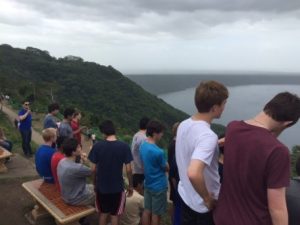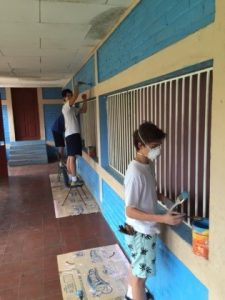It was 3am, and I was feeling nervous. 21 of us had arrived at DFW airport that morning for the immersion trip. Although, most of us had never met each other, we were all there in a similar situation, and we were there for one common goal. To participate in Jesuit Dallas’ 2015 immersion trip in Nicaragua and to live out the profile of the graduate while we were there.
Two groups, one from May 30- June 6 and another from June 27-July 4, journeyed to Central America, the twenty-one sophomores and juniors accompanied by Mr. Reese, Mr Perry, Ms. Ellsworth, Mr. Ornelas, Mr. Kelly, Mr. Murphy, and Mr. T.J. Howard. We flew into the capital city of Managua, and spent 1 week going to different parts of the country serving and forming relationships with the people that we met there. Along the way, we stopped at some tourist spots in Nicaragua to experience some of the local culture.
Many of us were uneasy even upon arrival. As most of us had never been to a foreign country before, many were surprised by the dynamic of the landing as well as the city layout. For example, many of us noticed that the airport was right in the middle of the city, something that most people hadn’t seen before. Michael Miramontes ’18 remarked. “There were trees and buildings everywhere. It was in a huge urban area. You don’t see that in the US.” After the excitement of arrival, a day of tourist activities began in Nicaragua, including lunch with our tour guide Gerald’s grandmother and her extended family in a town outside of Managua. We then drove to a mountain-top near the town and enjoyed the amazing view.
Despite the Fun, an immediate struggle that we encountered was the language barrier. It’s obviously difficult to try and interact with people when one doesn’t normally have to speak Spanish. Many of us only had a few years of classroom Spanish, and some students who took other languages such as Latin had no experience at all. Nick Sigman 18’ said, “I’d never been to a foreign country before. I had never had to speak another language or anything like that. It was a lot of using hand gestures such as pointing, and trying to figure out words. Sometimes I would call over someone who spoke Spanish to help translate for me.”
In a few days, after some of the tourist activities, the exciting parts of the trip began to start. One of the first service projects was the painting the dormitory of an orphanage for young girls (about 5-10 years old) in a remote part of the country. It took a few hours to get there, and it was hard work, however everyone enjoyed the experience. At the orphanage we met up with some students who attended a Jesuit school in Nicaragua. Michael Miramontes ‘18 remembers this as one of the first times that he connected with the locals “During a break, all the kids got out, including the Jesuit Nicaraguans and the orphans and we just played a game of soccer. It was just a cool moment where we were breaking the language barrier. It was just great that we were having fun with three completely different groups of people.” At the end of the project when we were finished, the little girls sang a traditional Nicaraguan song to us in thanks for our work as well as for our company. Because of the fact that the orphanage was isolated, They get very few visitors.
Another Project that we partook in was the painting of a building at a school for special needs students. This, unlike the last service project, was in a more urban part of Nicaragua. When we arrived, we were given a quick tour of the school. The school was comprised of mostly down syndrome and autistic children. However, the school had all different programs for all kinds of disabilities including blindness, deafness, etc.
After the tour, we went over to a classroom that was separate from everything else with the intent to paint the entire thing, inside and outside. During the project, we also took breaks to play with the school children who were outside. Nick Sigman remembers a funny experience that he had while playing with the school children. “I had my glasses and a necklace on, and I put it on one of the little boys. He was running around with them and it was really funny and everyone was laughing.” Although we did take some breaks, this was by far the biggest service project we undertook in Nicaragua. Despite the hard work, Nick Sigman also ’18 remembers this as his “favorite service project because it was really satisfying once we were finished, knowing that we did all that ourselves.”
After that, we walked around the corner to an elderly home where we met some of the people that we would be taking to the beach the next day. We talked with the people there and gave them ice cream so that we could know their names for the next day.
Preston James ’17 recounted an emotional experience that he had with the elderly people. “There was a woman there who had just gotten there that day. She was crying because it obviously wasn’t a very happy time for her being removed from her home by her neighbors and all. But we fed her ice cream and by the end of the day she was smiling and holding my hand and that was really meaningful to me.”
After taking the elderly to the beach and participating in a few other service projects as well as tourist activities, it was time to head home. Many of us agreed that this was by far one of the best experiences that we had ever had. The relationships we formed were radically eye opening, our notion of service changed drastically, and the brotherhood that this kind of trip forms is unparalleled.
Although we had arrived in Nicaragua with the intent to serve, we left knowing that the people that we met had helped us just as much as we had “helped” them.
For those interested in the many national, and international trips that Jesuit has to offer talk to Mr. Perry. The application process for the summer immersion trips usually begins in the Spring in March, however there are often various immersion trips throughout the year that travel to places in the United States such as LA and New Orleans.


